As a passionate explorer of both earthly cultures and celestial wonders, I find a unique connection between gazing at distant galaxies and understanding the intricate tapestry of our planet. Both invite us to look beyond the obvious, to delve into history, mystery, and breathtaking beauty. Stargazing, in particular, offers a profound experience, a bridge to the vastness of the universe that has captivated humanity for millennia, influencing culture, navigation, and our very sense of place. To truly unlock the wonders of the night sky and enhance this connection, especially when traveling to dark sky locations, selecting the right telescope for star watching is absolutely essential. Whether you’re a complete novice or a seasoned amateur astronomer, the perfect instrument can transform distant points of light into swirling nebulas or the scarred faces of faraway planets, making every glimpse an unforgettable journey.
Embarking on the search for your first telescope can feel like navigating the cosmos without a star chart. There’s a universe of options, each with its own technical jargon and set of capabilities. My goal, drawing from years of exploring diverse experiences and the deep satisfaction of discovery, is to help demystify this process. Think of this guide not just as a list of products, but as an introduction to unlocking new perspectives on the universe above. The right telescope for star watching isn’t just equipment; it’s a gateway to understanding the cosmos, deepening your appreciation for science, and connecting with a hobby enjoyed by cultures across history. Finding a suitable amateur astronomy telescope is a critical step in this journey.
Understanding the Journey: Choosing Your Telescope for Star Watching
Selecting a telescope for star watching involves considering where you’ll observe from, what you want to see, your budget, and your comfort level with technology. Just as different journeys require different modes of transport, different astronomical interests benefit from different telescope designs. Are you captivated by the intricate details of the moon and planets, or do you dream of capturing faint distant galaxies through astrophotography? Your answers will guide you towards the right type of telescope and features.
The quality of telescopes has improved dramatically, offering incredible capabilities at various price points. The most important factor is the optical quality – how clear and sharp the views are. Aperture, portability, and ease of use are also key considerations. For beginners, user-friendly features and straightforward setup can make all the difference between a frustrating experience and a lifelong passion.
Top Recommended Telescope for Star Watching Models in 2025
Based on extensive review and hands-on testing, here are some of the leading telescopes recommended for enhancing your star watching experiences in 2025, suitable for various needs and skill levels.
Best Telescope for Star Watching for Beginners
Celestron NexStar 4SE
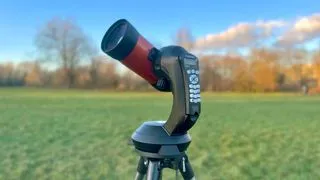 A Celestron NexStar 4SE telescope for star watching set up outdoors in a field near sunset
A Celestron NexStar 4SE telescope for star watching set up outdoors in a field near sunset
Ideal for those taking their first steps into the cosmos, the Celestron NexStar 4SE combines ease of use with impressive performance. Its Maksutov-Cassegrain design and computerized Alt-Azimuth mount, featuring Celestron’s SkyAlign technology, make locating celestial objects almost effortless. Simply input the date, time, and your location, align on a few bright stars, and the telescope can automatically find thousands of objects.
With a 4-inch (102mm) aperture and a long 1325mm focal length, this telescope for star watching delivers sharp, bright views of planets and the moon. While its narrow field of view is less suited for large deep-sky objects, it excels at detailed planetary observation. The sturdy build is a plus, though its 23 lbs weight and non-folding tripod make it better suited for backyard observing than frequent travel. It requires 8 AA batteries, which drain quickly, so an external power source is recommended for longer sessions. Overall, it’s a high-quality instrument that simplifies the learning curve for new stargazers.
Best Budget Telescope for Star Watching
Celestron Inspire 100AZ Refractor
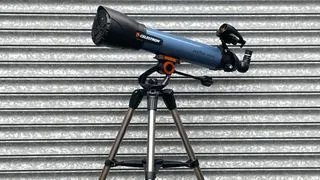 A side view of a Celestron Inspire 100AZ telescope for star watching against a textured wall
A side view of a Celestron Inspire 100AZ telescope for star watching against a textured wall
For aspiring astronomers on a budget, the Celestron Inspire 100AZ Refractor is a fantastic starting point. This refractor telescope features a 4-inch (100mm) aperture and a 660mm focal length, providing sharp views of the moon and planets. Its Alt-azimuth mount is simple to operate, moving up/down and side-to-side, making manual tracking straightforward.
One standout feature is the lens cap, which ingeniously converts into a smartphone adapter, allowing beginners to easily dabble in astrophotography by capturing images through the eyepiece. It comes with essential accessories, including two eyepieces, a red LED flashlight to preserve night vision, and a finderscope. While it might exhibit some slight chromatic aberration (color fringing) on very bright objects and lacks GoTo automation, its user-friendly design, included accessories, and affordable price make it a top choice for anyone seeking a cost-effective telescope for star watching. A quality hobby telescope like this can provide hours of enjoyment.
Best Value Telescope for Star Watching for Enthusiasts
Celestron Astro Fi 130
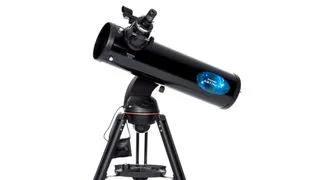 A Celestron Astro Fi 130 telescope for star watching on a white background
A Celestron Astro Fi 130 telescope for star watching on a white background
Offering an excellent balance of performance and price for enthusiasts, the Celestron Astro Fi 130 is a computerized Newtonian Reflector. Its 5.19-inch (130mm) aperture and 650mm focal length provide bright, wide views suitable for both planets and larger deep-sky objects like galaxies and nebulas.
This telescope for star watching stands out with its integrated WiFi, allowing control via the Celestron SkyPortal app on your smartphone or tablet. The app not only controls the GoTo mount but also provides information about celestial objects and can even recommend targets visible from your location. This smart functionality makes navigating the night sky incredibly intuitive. While the included eyepieces are basic, upgrading them can significantly enhance the viewing experience. It’s portable at 18 lbs and offers great value for its capabilities, though battery drain in cold weather is something to keep in mind.
Best Premium Telescope for Star Watching
Celestron NexStar Evolution 9.25
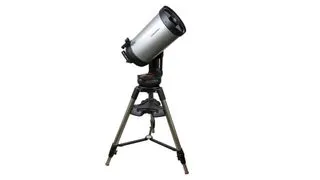 A Celestron NexStar Evolution 9.25 telescope for star watching on a tripod on a white background
A Celestron NexStar Evolution 9.25 telescope for star watching on a tripod on a white background
For those seeking top-tier performance and willing to invest, the Celestron NexStar Evolution 9.25 is a remarkable instrument. This Schmidt-Cassegrain telescope boasts a large 9.25-inch (235mm) aperture and a long 2350mm focal length, delivering exceptionally crisp and detailed views across a wide range of celestial objects.
Its robust computerized Alt-Azimuth fork arm mount features a rechargeable lithium-ion battery providing up to 10 hours of power – perfect for extended observing sessions. Like other NexStar Evolution models, it integrates seamlessly with the SkyPortal app for easy control and object finding. The large aperture gathers ample light for stunning views of planets, nebulas, and galaxies. While its size and weight (62.6 lbs) make it less portable, it’s a superb choice for backyard astronomers or those with a dedicated observing setup who demand the highest quality telescope for star watching.
Best Telescope for Star Watching for Astrophotography
Celestron Origin Intelligent Home Observatory
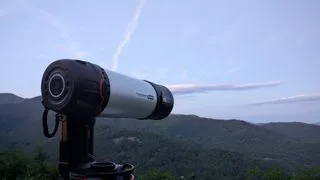 A Celestron Origin Intelligent Home Observatory telescope for star watching in a field
A Celestron Origin Intelligent Home Observatory telescope for star watching in a field
The Celestron Origin revolutionizes astrophotography for enthusiasts. This smart telescope, based on a Rowe-Ackermann Schmidt Astrograph (RASA) design, replaces the traditional eyepiece with a built-in camera, allowing you to view and capture stunning images directly on your mobile device.
With a 6-inch (152mm) aperture and a fast 335mm focal length, it excels at capturing wide-field deep-sky objects. Its automated system handles focusing, tracking, and even stacks images in real-time to produce crystal-clear photos in seconds, even under light-polluted skies. The accompanying app makes setup and object selection incredibly simple. While it’s not designed for traditional visual observing and has a premium price tag ($4,000+), it’s an exceptional telescope for star watching if your primary interest is sharing beautiful astroimages.
Best Motorized Telescope for Star Watching
Celestron NexStar 8SE
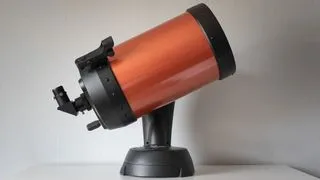 A Celestron NexStar 8SE telescope for star watching with hand controller
A Celestron NexStar 8SE telescope for star watching with hand controller
Often hailed as “The World’s Most Beloved Telescope,” the Celestron NexStar 8SE is a versatile and powerful computerized telescope for star watching. Its 8-inch (203mm) Schmidt-Cassegrain optical tube provides incredibly bright and sharp views, suitable for beginners and experienced astronomers alike.
The computerized Alt-Azimuth fork arm mount features a GoTo system controlled by a hand controller (or optionally via the SkyPortal app). After a simple three-star alignment using SkyAlign, the telescope can automatically slew to any object in its extensive database. The catadioptric design allows for a relatively compact tube despite the long 2032mm focal length, enhancing portability. Its smooth and accurate tracking makes it a great option for both visual observation and astrophotography. While it’s a significant investment and requires 8 AA batteries (rechargeables recommended), its performance and ease of use justify the cost for a long-term telescope for star watching.
Best Telescope for Star Watching for Portability
Celestron Astro Fi 102
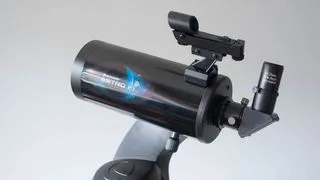 A Celestron Astro Fi 102 telescope for star watching on a tripod against a plain background
A Celestron Astro Fi 102 telescope for star watching on a tripod against a plain background
If you live in an urban area with significant light pollution and plan to travel to darker skies, portability is key. The Celestron Astro Fi 102 is our top recommendation for a lightweight and easy-to-transport computerized telescope for star watching. Weighing just 6 lbs (2.7kg), its compact Maksutov-Cassegrain design is ideal for taking on camping trips or venturing outside city limits.
This GoTo scope uses integrated WiFi and the SkyPortal app for control, making it simple for beginners to find celestial objects from a database of 100,000 targets. With a 4-inch (102mm) aperture and 1325mm focal length, it provides good views of the moon and planets. While the tripod is somewhat basic and the optics show minor sharpness drop-off at the edges compared to premium models, its convenience, ease of setup, and affordable price make it an excellent choice for mobile stargazers.
Best Telescope for Star Watching for Accessories
Sky-Watcher Skymax 150 PRO
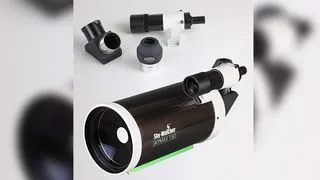 A Sky-Watcher Skymax 150 PRO telescope for star watching with accessories
A Sky-Watcher Skymax 150 PRO telescope for star watching with accessories
Designed with expandability in mind, the Sky-Watcher Skymax 150 PRO Maksutov-Cassegrain telescope is a versatile instrument, especially for astrophotographers who like to customize their setup. It features a 5.9-inch (150mm) aperture and a long 1800mm focal length, delivering sharp, distortion-free views perfect for capturing everything from planetary details to distant nebulas and galaxies.
This telescope for star watching comes with a high-quality Equatorial (EQ-5 Pro) mount, suitable for both short and long exposures. Its Vixen-style dovetail plate and robust construction easily accommodate a wide range of accessories, including CCD or DSLR cameras, filter wheels, and more. Weighing 13.23 lbs, it’s relatively lightweight for its aperture, making it suitable for transport to dark sky sites. The smooth focuser and excellent optics make it a great value option for astronomers and astrophotographers of all levels. Note that not all models include a tripod, so check the package details carefully.
Best Smart Telescope for Star Watching
Unistellar eQuinox 2 telescope
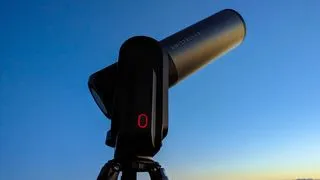 A Unistellar eQuinox 2 telescope for star watching in use against a starry night sky
A Unistellar eQuinox 2 telescope for star watching in use against a starry night sky
The Unistellar eQuinox 2 represents the cutting edge of smart telescopes. This motorized Newtonian Reflector, controlled entirely via a sleek smartphone app, offers an incredibly simple and automated stargazing experience. It features a 4.49-inch (114mm) aperture and a 450mm focal length.
Unlike traditional telescopes, the eQuinox 2 doesn’t have an eyepiece; instead, it uses a built-in image sensor (6.2MP) to capture and stack images in real-time, displaying enhanced views directly on your device screen. Its Smart Light Pollution Reduction feature is particularly beneficial for urban observers, allowing clear views even under bright city lights. Setup is quick and easy using Autonomous Field Detection. The app provides access to a vast database of celestial objects and guides the telescope automatically. While it comes at a premium price and doesn’t offer the traditional visual experience, it’s an impressive telescope for star watching for those prioritizing convenience, automation, and digital sharing of celestial views.
Best Telescope for Star Watching for Deep Space
Celestron Advanced VX 8 EdgeHD
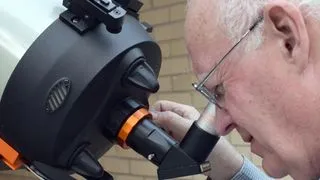 A Celestron Advanced VX 8 EdgeHD telescope for star watching with its mount
A Celestron Advanced VX 8 EdgeHD telescope for star watching with its mount
Aimed at serious amateur astronomers and astrophotographers, the Celestron Advanced VX 8 EdgeHD is engineered for exceptional performance, especially for deep-sky observing and imaging. Its 8-inch (203.2mm) Schmidt-Cassegrain optical design features EdgeHD technology, which corrects for field curvature, ensuring pinpoint sharpness across the entire image frame – crucial for detailed astrophotography.
Paired with the motorized Equatorial (Advanced VX) mount, this telescope for star watching can accurately track celestial objects for long-exposure imaging and provides stable support for up to 30 lbs of gear. Views of planets, globular clusters, and galaxies are incredibly crisp and detailed. The setup uses the NexStar+ hand controller or can be controlled via the SkyPortal app. While setting up an equatorial mount requires some knowledge, this telescope offers professional-level performance and is an instrument you won’t quickly outgrow, providing stunning views of distant cosmic wonders.
Best Telescope for Star Watching for Kids
Celestron FirstScope 76 Tabletop telescope
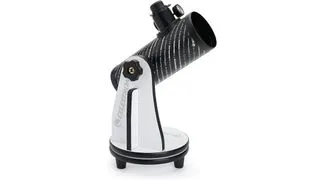 A Celestron FirstScope 76 Tabletop telescope for star watching on a white background
A Celestron FirstScope 76 Tabletop telescope for star watching on a white background
Introducing young minds to the wonders of the night sky is easy with the Celestron FirstScope 76 Tabletop telescope. This simple, robust Reflector telescope is designed for beginners, especially children. It comes fully assembled in the box, ready for immediate use – perfect for impatient aspiring astronomers.
With a 2.99-inch (76mm) aperture and a 300mm focal length, it offers decent views of the moon and bright celestial objects. Its Dobsonian tabletop mount is intuitive and easy for small hands to maneuver. It includes two basic eyepieces (4mm and 20mm) and is built from durable plastics. While it lacks a finderscope (a separate red dot finder is highly recommended) and its optics aren’t the most powerful, its low cost, ease of use, and sturdy build make it an ideal first telescope for star watching to spark a lifelong interest in astronomy.
Understanding the Language of Your Telescope for Star Watching
Delving into the world of telescopes means encountering specific terms. Understanding them is key to choosing the right instrument and making the most of your observations.
- Aperture: The size of the telescope’s main light-gathering element (lens or mirror). A larger aperture collects more light, revealing fainter objects and finer details. It’s the most crucial specification for a telescope for star watching.
- Focal Length: The distance from the objective lens/primary mirror to the point where light converges to form an image. Longer focal lengths result in higher magnification with a given eyepiece.
- Magnification: How much larger an object appears through the telescope compared to the naked eye. Calculated by dividing the telescope’s focal length by the eyepiece’s focal length. Higher magnification spreads light over a larger area, reducing brightness and requiring steady atmospheric conditions. Useful magnification is limited by aperture and atmospheric seeing.
- Eyepiece: A small lens or set of lenses inserted into the telescope’s focuser to magnify the image formed by the objective. Changing eyepieces changes magnification.
- Finderscope: A small, low-magnification scope mounted parallel to the main telescope. With a wider field of view, it helps you locate celestial objects and center them before viewing through the higher-magnification main scope eyepiece.
Types of Telescope for Star Watching Explained
Understanding the basic optical designs helps clarify their strengths and weaknesses for star watching:
- Refractor Telescopes: Use lenses to bend light. Simple, low maintenance, good for moon and planets, typically sharp views but can suffer from chromatic aberration (color fringing) in cheaper models.
- Reflector Telescopes: Use mirrors to reflect light. Offer larger apertures for less cost, excellent for faint deep-sky objects. Require occasional mirror alignment (collimation) and cleaning. Newtonian and Dobsonian are common types.
- Catadioptric Telescopes: Combine lenses and mirrors (e.g., Schmidt-Cassegrain, Maksutov-Cassegrain). Offer compact design, versatility for planets and deep-sky, often feature GoTo mounts. Can be more expensive than equivalent aperture reflectors.
Knowing these types helps you align your star watching goals with the right instrument design.
How We Evaluate a Telescope for Star Watching
Our recommendations are based on thorough testing and real-world observation. We assess each telescope for star watching on several factors:
- Optical Performance: Clarity, sharpness, brightness of views, presence of aberrations (distortion, false color).
- Build Quality & Design: Sturdiness, durability, ease of assembly and handling.
- Functionality: Ease of focus, mount stability and movement (manual or motorized), effectiveness of alignment systems (GoTo, SkyAlign), usability of included accessories.
- Ease of Use: How beginner-friendly is the setup and operation? Does it require extensive prior knowledge?
- Portability: How easy is it to transport for observing away from home? (Weight, size, tripod design).
- Value: Does the performance and feature set justify the price?
We test telescopes under various conditions, observing planets like Jupiter and Saturn, the moon, and deep-sky objects to evaluate their capabilities and verify manufacturer claims, drawing on years of experience in astronomical observation.
Telescope for Star Watching: Frequently Asked Questions
How do I choose the right telescope for star watching for me?
Consider what you want to observe (planets, moon, deep sky), where you’ll be observing (backyard, dark sky site – affects portability needs), your budget, and your comfort level with setup and technology (manual vs. computerized GoTo). Beginners often benefit from user-friendly refractors or computerized GoTo scopes.
What types of telescope for star watching are there?
The three main types are Refractor (uses lenses), Reflector (uses mirrors – like Newtonian and Dobsonian), and Catadioptric (uses both lenses and mirrors – like Schmidt-Cassegrain and Maksutov-Cassegrain). Each has different strengths and ideal uses.
How does a refractor telescope for star watching work?
A refractor uses an objective lens at the front to bend light and focus it at the back, where the eyepiece magnifies the image. They are known for sharp planetary and lunar views and are generally low maintenance.
How does a reflector telescope for star watching work?
A reflector uses a large primary mirror at the back to gather light, which is then reflected to a smaller secondary mirror near the front. The secondary mirror directs the light to the eyepiece, usually on the side of the tube. They offer great light-gathering power for their cost, making them excellent for deep-sky objects.
How does a catadioptric telescope for star watching work?
A catadioptric telescope uses a combination of mirrors and a corrector lens at the front of the tube. This design allows for long focal lengths within a compact tube, making them versatile for both planetary and deep-sky viewing.
What is a finderscope on a telescope for star watching?
A finderscope is a small, low-power telescope mounted parallel to the main scope. It has a wider field of view, making it easier to locate celestial objects in the sky and then center them in the main telescope’s narrower view.
What does aperture, magnification and focal length mean on a telescope for star watching?
- Aperture: The diameter of the main lens or mirror, determining light-gathering ability and resolving power. Larger aperture means brighter views and more detail.
- Focal Length: The distance it takes light to come to a focus point. Affects magnification.
- Magnification: How much the image is enlarged. Determined by dividing the telescope’s focal length by the eyepiece’s focal length.
Magnification: How do telescope eyepieces work for star watching?
Eyepieces magnify the image formed by the telescope’s objective. Each eyepiece has a focal length; shorter focal lengths produce higher magnification. You change eyepieces to change magnification.
The Sky Awaits Your Discovery
Exploring the night sky with a telescope for star watching is more than just a hobby; it’s an invitation to connect with the universe on a fundamental level. It’s an experience that complements the discovery inherent in travel, culture, and history, reminding us of our place in the cosmos. Whether you choose a simple manual reflector or a sophisticated smart telescope, the journey of celestial discovery is incredibly rewarding. May your views be clear and your nights filled with wonder.
